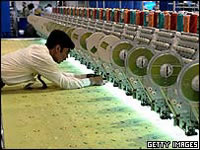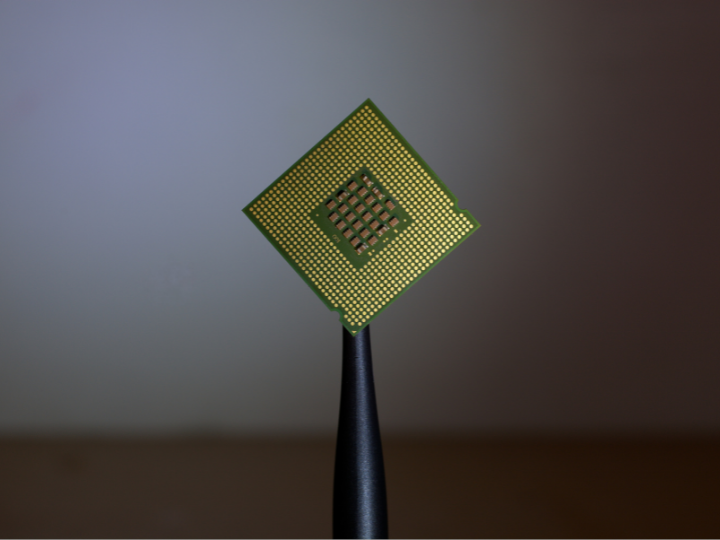Six months after the ending of the Multi-Fibre Agreement (MFA) which regulated trade in textiles and clothing for 30 years, a rise in exports from Pakistan's textile industry is driving the country's highest economic growth in 20 years.
Many would be surprised at the vibrancy of the textile and clothing industry in Pakistan.
In a country racked by political instability in parts, business continues as usual in textile mills and stitching units of Lahore and Karachi's cosmopolitan industrial centres and in the dusty textile city of Faisalabad.
There are 200 textile and clothing companies listed on the Karachi Stock Exchange.
Textiles and clothing make up 60% of Pakistan's exports and employs half of the industrial workforce.
In 2003, Pakistan was the world's eighth largest exporter of textile and clothing products, behind India, Japan the EU and USA.
The industry is doing its best to respond to the changing global context brought about by the ending of the MFA, which was intended to help boost trade from developing countries.
Business people are investing in new technologies, in regular contact with buyers, and in touch with the latest trends in fashion and fabrics.
Modernising companies
One such company is Masood Textile Mills, a leading exporter of polo shirts, sportswear and bed wear to major US chains such as Sears and JC Penney.
Located in Faisalabad, it is a vertically integrated company that conducts spinning of yarn, knitting, dying and stitching of fabric, all in-house.
With 8,000 employees in its factories, its staff include 200 MBAs, textile engineers and industrial engineers as well as workers from surrounding areas.
Companies like Masood have been upgrading machinery in the heavily mechanised textile manufacturing sector, using the latest spinning and dying technology imported from Japan and Switzerland.
The more labour intensive stitching sector requires high quality finishing on bed linen, curtains and clothing certified to international standards and destined for western markets, fed by the cotton crop from Punjab and Sindh provinces and by top quality US prima cotton, of which Pakistan is the largest importer.
Seizing the moment
The Multi-Fibre Agreement (MFA) was in place from 1974 to December 2004 and governed global trade in textiles and clothing through a system of quotas.
The removal of limits on exports from countries such as China, India and Pakistan has led to a rapid reorganisation of trade in the past six months. Before the ending of the MFA, the outlook across both textiles and clothing in Pakistan was truly uncertain.
Some textile bosses were quietly optimistic,
but there were widespread fears about the impact of exports from China and of massive job losses. According to government statistics, however, exports of textiles and clothing have grown 10% since December 2005.
Highest growth has been seen in Pakistan's most competitive products, with increases of 29% in bed linen and 20% in cotton cloth.
Boom times
In May 2005, Pakistan also announced its highest annual economic growth rate in 20 years of 8.4% annually.
Arif Saeed, President of the All Pakistan Textile Mills Association, believes that it is double-digit growth across his industry that is driving this achievement. "The significant growth in fabrics and home textiles such as bed linen since the ending of the quota system has arisen from the investments made by firms in preparation for the ending of the Multi Fibre Agreement. Pakistan's competitive advantage in these categories has come from its ability to adopt of the latest technologies faster than its competitors," he said.
This is an optimistic time for Pakistan. Renewed hope of peace with India and the potential introduction of trade links is boosting business prospects.
The long-awaited, highly controversial, part-privatisation of the Pakistan Telecommunication Company took place in June, with hopes of further privatisations to come.
A recovery in agriculture and a strong performance in the service sector are also driving record growth.
Strong growth could also help the 30% of Pakistan's population that live under the poverty line, including many women.
On average one third of the textile and clothing industry's workers are female compared with a national average of 15%.
Roadblocks ahead
The private sector in Pakistan, however, remains constrained.
Firms are plagued by regular interruptions to the electricity supply and many textile plants have built their own power plants to avoid power cuts, but at additional expense.
Infrastructure is poor in places, as seen on the heavily congested, narrow roads of Faisalabad. Telecommunications are also frequently interrupted.
The clothing sector, as opposed to textiles, has also been performing less well in the face of competition from China.
Exporters lack the skills required to expand the sector and firms report a drop in sales from last year.
Once buyers come to Pakistan, however, Shahid Nazir, chief executive of Masood Textile Mills, believes that they become more confident about sourcing from the country.
Indeed, JC Penney, one of America's largest department stories and a customer of Masood, has recently announced that it will double is purchases from Pakistan because of increasing quality of production.
Producers are also optimistic that once global prices of apparel and clothing settle down and the diversion of production to less competitive regions that occurred under the quota system disappears, Pakistan will be in a good position to capture business.
If this is the case, the ending of the MFA will be good not only for the textile and clothing industry, but will improve perceptions of Pakistan as a whole as a place to do business.




 By: N. Peter Kramer
By: N. Peter Kramer
